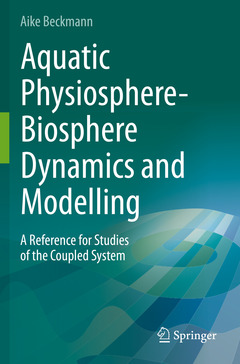Description
Aquatic Physiosphere-Biosphere Dynamics and Modelling, 1st ed. 2021
A Reference for Studies of the Coupled System
Author: Beckmann Aike
Language: English
Subjects for Aquatic Physiosphere-Biosphere Dynamics and Modelling:
Approximative price 232.09 €
In Print (Delivery period: 15 days).
Add to cart
Aquatic Physiosphere-Biosphere Dynamics and Modelling
Publication date: 02-2022
582 p. · 15.5x23.5 cm · Paperback
Publication date: 02-2022
582 p. · 15.5x23.5 cm · Paperback
Approximative price 232.09 €
In Print (Delivery period: 15 days).
Add to cart
Aquatic Physiosphere-Biosphere Dynamics and Modelling
Publication date: 02-2021
582 p. · 15.5x23.5 cm · Hardback
Publication date: 02-2021
582 p. · 15.5x23.5 cm · Hardback
Description
/li>Contents
/li>Biography
/li>Comment
/li>
This encyclopedia is a reference for aquatic physical, biological and biogeochemical sciences, collecting and connecting a number of topics, concepts and facts about aquatic systems and their scientific investigation. The scope of the book comprises the aquatic physiosphere-biosphere transition zone, an entity that encompasses both inanimate matter and collectives (the physiosphere) as well as living organisms and collectives (the biosphere). This combined approach is meaningful because both realms are intimately linked and because available methods of investigation are often similar. Much can be gained from considering both spheres at and across their interface jointly, and while there is a strong focus on marine systems, most concepts presented are also applicable to freshwater systems. This presented snapshot of knowledge of the transition zone between the aquatic physiosphere and biosphere is taken from a very specific angle: the point of view of a modeler. Modeling is not only a state-of-the-art mode of scientific investigation, but also requires the explicit specification of all assumptions (helping to avoid fallacies), and offers the advantage of being quantitative and allows for theoretical "what if" scenarios.
As in any reference work, equal emphasis is given to fundamental facts, the definition of terms and the explanation of concepts, in an attempt to establish a joint language for physicists, biologists and biogeochemists. Although originating from a modeler's approach to nature, the resulting suite of compatible concepts may also be useful beyond modeling purposes. Furthermore, the material is presented in a condensed, straightforward way. Hence, the length of each entry is limited to one (occasionally two) pages, thus offering a quick introductory overview. This excludes lengthy derivations and very specialized details. The book is geared towards researchers, teachers and advanced students in the field of aquatic (marine and limnic) sciences, in particular those interested or involved in interdisciplinary work.
1. Earth System Science.- 2. Ecosystems, Regions, Regimes.- 3. Scientific Methods and Concepts.- 4. Systems Theory.- 5. Water Properties.- 6. Fluid Dynamics Concepts.- 7. Hydrodynamic System of Equations.- 8. Coordinate Systems.- 9. Hydrodynamic Approximations and Balances.- 10. Physical Processes and Phenomena.- 11. Waves, General.- 12. Mechanical Waves.- 13. Boundaries.- 14. Tides.- 15. Topographic Effects.- 16. Ice.- 17. Mathematical Basics.- 18. Differential Equations.- 19. Discrete Mathematics.- 20. Mathematical Concepts and Methods.- 21. Discretized Prototype Equations.- 22. Numerical Concepts and Methods.- 23. Models and Modelling.- 24. Subgridscale Parametrizations.- 25. Carbonate Chemistry.- 26. Biological, Biogeochemical and Ecological Concepts.- 27. Planktonic Organisms.- 28. Life Processes.- 29. Limited Growth.- 30. Primary Production.- 31. Species Interactions.- 32. Biospheric Modeling Concepts and Models.- 33. Aquatic Element Cycling.
Dr. Aike Beckmann (retired) is a physical oceanographer by training and has worked for more than 30 years in the areas of ocean and sea ice modelling at various research institutions, both nationally and internationally. He has authored and co-authored 62 peer-reviewed publications in international journals and encyclopedias. His areas of expertise cover numerous aspects of the marine hydrosphere (ocean circulation, waves, water masses from local to global scales) and cryosphere (sea ice, ice shelves, coupling to atmosphere and ocean), and more recently, the marine biosphere (models of ecosystem dynamics and biogeochemical cycling). His main method of investigation is numerical modelling. Moreover, he has been involved in university teaching of about 20 years, giving numerous lectures, seminars and exercises on physical oceanography, hydrodynamics, sea ice, numeral modelling and dynamics of aquatic ecosystems.
Provides a reference for aquatic physical, biological and biogeochemical sciences
Offers a combined consideration of the aquatic physiosphere and biosphere
Focuses on a modelling perspective in the explanation of terms and concepts
© 2024 LAVOISIER S.A.S.




